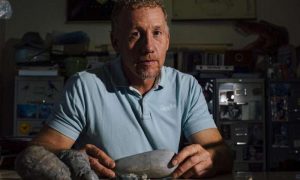
Credit: Montana State University
A recent theory by paleontologists at Montana State University suggests that the nesting habits of some Mesozoic-era dinosaurs further bolsters the theory that all birds, from the majestic bald eagles of Yellowstone National Park to robins nesting in backyards across Montana, evolved from dinosaurs that lived millions of years ago.
“Reproduction in modern birds is distinct among living vertebrates and many aspects of this (modern bird) reproduction mode trace their origin to (Mesozoic-era) theropod dinosaurs such as Oviraptors and Troodontids, but not really beyond them to more distantly related dinosaurs,” said David Varricchio, associate professor of paleontology in MSU’s Department of Earth Sciences in the College of Letters and Science.
Varricchio said reproduction in the most common group of Mesozoic birds is very similar to that of these dinosaurs, and so still differs from modern birds. Consequently, modern birds stand apart from Mesozoic birds, and their more efficient incubation of eggs perhaps contributed to their surviving the end-Cretaceous extinction event, which led to the mass extinction of about 75 percent of plant and animal species on Earth.
In a paper published in August in the international journal The Auk: Ornithological Advances, Varricchio and MSU Assistant Research Professor Frankie Jackson examined the evolution of bird reproduction through a series of distinct stages, from pre-avian dinosaurs to the birds of today.
“We found Troodon formosus to have many avian attributes, but still differ from modern birds,” Varricchio said of the Montana dinosaur with serrated teeth that weighed around 100 pounds.
Troodons share many reproductive traits with modern birds, such as having a hard-shelled egg. However, according to Varricchio, troodons differ reproductively from modern birds in several ways, too. One of these ways is that they partially buried their eggs in the sand or earth, rather than nesting wholly on top of the surface. The most abundant birds of the Mesozoic, called Enantiornithines, still buried their elongated eggs, at least in part, as did the troodons, Varricchio said. Modern birds were the first to lay the familiarly shaped eggs we know today and incubate them without any burial within sediment, which scientists believe improved the efficiency of brooding and may have been important to their ultimate success as a species.
“This tells us something about how those particular dinosaurs reproduced,” Varricchio said. “We can’t ask why they evolved that way without knowing when those traits evolved and under which conditions they evolved. We need the historic context.”
In an unorthodox move, Varricchio and Jackson chose to publish their work in The Auk, an international journal pertaining to birds, rather than in a paleontological publication, in an attempt to work toward a consensus that has divided scientists in the respective disciplines.
“Ninety-nine percent of paleontologists believe that all modern birds are dinosaurs, but, there’s still some resistance from ornithologists on that point,” Varricchio said. “People have argued about the bird-dinosaur connection since the 1800s. But, since then, there has been overwhelming skeletal evidence [to support the connection]. Then in 1996, we learned that some dinosaurs had feathers. Well, their reproduction follows that pattern, as well.”
According to Varricchio, ornithologists point to a limited sample size of specimens to cause them to rethink fully the fundamentals of their field of study.
“There’s a pretty good record of how reproduction evolved from dinosaurs to modern birds,” he said. “It’s more of them seeing holes in the data sets or a lack of specimens, which is a pretty good argument. We might have one or two specimens rather than hundreds—and that’s a fair argument.”
That Varricchio and Jackson are inviting criticism of their work by publishing in The Auk shows their dedication to furthering science, said Mary Hubbard, head of MSU’s Department of Earth Sciences.
“As a department, we are proud to have David and Frankie working on such cutting-edge science and the fact that they are reaching out to scientists who might criticize their work sets a nice example for their students to see,” Hubbard said. “One of the ways that science advances is through controversy.”
Varricchio said he is looking forward to hearing what ornithologists have to say about the research.
“It will be fruitful to get their feedback, to hear from them what they find problematic,” he said. “It’s good to get pushback. I hope to win them over, and I’m hoping to get some criticism. If we move to a better consensus, it would be a good step forward for science.”
Reference:
David J. Varricchio et al. Reproduction in Mesozoic birds and evolution of the modern avian reproductive mode, The Auk (2016). DOI: 10.1642/AUK-15-216.1
Note: The above post is reprinted from materials provided by Montana State University.










